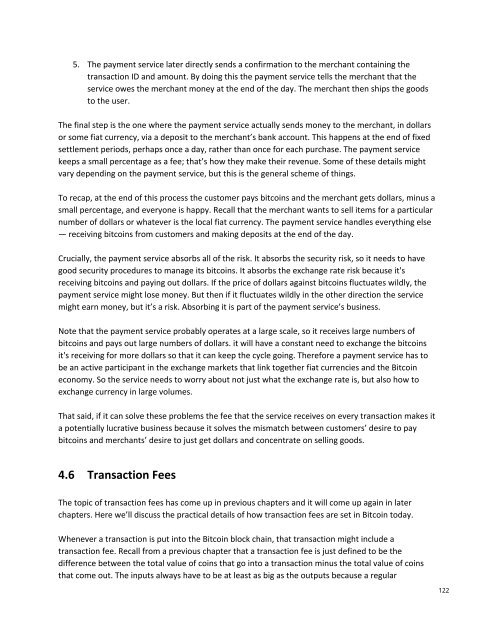Bitcoin and Cryptocurrency Technologies
1Qqc4BN
1Qqc4BN
You also want an ePaper? Increase the reach of your titles
YUMPU automatically turns print PDFs into web optimized ePapers that Google loves.
5. The payment service later directly sends a confirmation to the merchant containing the<br />
transaction ID <strong>and</strong> amount. By doing this the payment service tells the merchant that the<br />
service owes the merchant money at the end of the day. The merchant then ships the goods<br />
to the user.<br />
The final step is the one where the payment service actually sends money to the merchant, in dollars<br />
or some fiat currency, via a deposit to the merchant’s bank account. This happens at the end of fixed<br />
settlement periods, perhaps once a day, rather than once for each purchase. The payment service<br />
keeps a small percentage as a fee; that’s how they make their revenue. Some of these details might<br />
vary depending on the payment service, but this is the general scheme of things.<br />
To recap, at the end of this process the customer pays bitcoins <strong>and</strong> the merchant gets dollars, minus a<br />
small percentage, <strong>and</strong> everyone is happy. Recall that the merchant wants to sell items for a particular<br />
number of dollars or whatever is the local fiat currency. The payment service h<strong>and</strong>les everything else<br />
— receiving bitcoins from customers <strong>and</strong> making deposits at the end of the day.<br />
Crucially, the payment service absorbs all of the risk. It absorbs the security risk, so it needs to have<br />
good security procedures to manage its bitcoins. It absorbs the exchange rate risk because it's<br />
receiving bitcoins <strong>and</strong> paying out dollars. If the price of dollars against bitcoins fluctuates wildly, the<br />
payment service might lose money. But then if it fluctuates wildly in the other direction the service<br />
might earn money, but it’s a risk. Absorbing it is part of the payment service’s business.<br />
Note that the payment service probably operates at a large scale, so it receives large numbers of<br />
bitcoins <strong>and</strong> pays out large numbers of dollars. it will have a constant need to exchange the bitcoins<br />
it's receiving for more dollars so that it can keep the cycle going. Therefore a payment service has to<br />
be an active participant in the exchange markets that link together fiat currencies <strong>and</strong> the <strong>Bitcoin</strong><br />
economy. So the service needs to worry about not just what the exchange rate is, but also how to<br />
exchange currency in large volumes.<br />
That said, if it can solve these problems the fee that the service receives on every transaction makes it<br />
a potentially lucrative business because it solves the mismatch between customers’ desire to pay<br />
bitcoins <strong>and</strong> merchants’ desire to just get dollars <strong>and</strong> concentrate on selling goods.<br />
4.6 Transaction Fees<br />
The topic of transaction fees has come up in previous chapters <strong>and</strong> it will come up again in later<br />
chapters. Here we’ll discuss the practical details of how transaction fees are set in <strong>Bitcoin</strong> today.<br />
Whenever a transaction is put into the <strong>Bitcoin</strong> block chain, that transaction might include a<br />
transaction fee. Recall from a previous chapter that a transaction fee is just defined to be the<br />
difference between the total value of coins that go into a transaction minus the total value of coins<br />
that come out. The inputs always have to be at least as big as the outputs because a regular<br />
122









